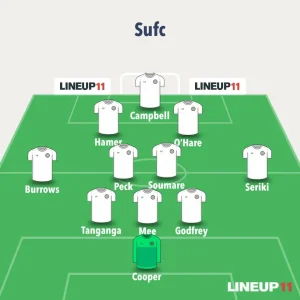Liaminho9
Well-Known Member
Season ticket holder for over 25 years. I’ve been in London for the past five, still making the trips back (and lining the pockets of EMR’s CEO every other week).
Today was grim. The side looks more disjointed than I can remember. For me, the core issue isn’t just individuals being off form, it’s the structure—especially in midfield—and how that cascades across the entire team.
1. The midfield problem
At our best last season, we had a functional pivot:
Now, Peck is being asked to do both jobs. He’s tackling, recovering, and immediately trying to progress. The problem: by the time he looks up, the forward line hasn’t shifted. He plays it anyway, but 80–90% of the time it’s into a static front line. The move dies before it starts.
2. Knock-on effects
This midfield imbalance has consequences everywhere else:
Because the wing-backs aren’t advancing, both wingers are left isolated. And since both are inverted, their only real option is to cut inside—every single time. Opposition defences know it, set themselves, and suddenly our strikers are outnumbered two or three to one in the box. We end up recycling sideways or losing it altogether.
4. Why it matters
This isn’t about a few players being off colour—it’s systemic. A chain reaction that starts with imbalance in midfield and ripples across defence and attack. Without a destroyer-creator balance, everything else collapses:
TLDR
I’m not claiming to be an expert or a coach—I’ve got no badges, just years of watching football home and away. But when you’ve seen enough games, you start to notice patterns, and this one has been obvious from the first whistle of the season. That said, football’s all about perspective, and I’d genuinely welcome other views. Maybe I’m over-simplifying it, maybe I’ve missed something. Either way, it would be good to hear how others are reading the same problems.
Today was grim. The side looks more disjointed than I can remember. For me, the core issue isn’t just individuals being off form, it’s the structure—especially in midfield—and how that cascades across the entire team.
1. The midfield problem
At our best last season, we had a functional pivot:
- Souza: the destroyer. Broke up play, did the dirty work, and released the ball quickly.
- Peck: the playmaker. Received it, dictated tempo, fed the attackers.
Now, Peck is being asked to do both jobs. He’s tackling, recovering, and immediately trying to progress. The problem: by the time he looks up, the forward line hasn’t shifted. He plays it anyway, but 80–90% of the time it’s into a static front line. The move dies before it starts.
2. Knock-on effects
This midfield imbalance has consequences everywhere else:
- Forwards: O’Hare and Hamer aren’t turning possession over high up the pitch, because they’re already advanced, waiting for service that never comes. It leaves them spectators until the ball is lost.
- Centre-backs: with the midfield screen missing, the two CBs are exposed. They’re being asked to defend wider spaces with less protection.
- Wing-backs: Burrows and Seriki are neutralised. A wing-back system relies on them breaking forward to give width and overlaps. Instead, they’re pinned back, constantly firefighting, which means we never stretch teams horizontally.
Because the wing-backs aren’t advancing, both wingers are left isolated. And since both are inverted, their only real option is to cut inside—every single time. Opposition defences know it, set themselves, and suddenly our strikers are outnumbered two or three to one in the box. We end up recycling sideways or losing it altogether.
4. Why it matters
This isn’t about a few players being off colour—it’s systemic. A chain reaction that starts with imbalance in midfield and ripples across defence and attack. Without a destroyer-creator balance, everything else collapses:
- Defence is stretched.
- Wing-backs can’t provide width.
- Wingers are predictable.
- Strikers are isolated.
TLDR
- Peck is being asked to do both destroyer and playmaker roles.
- That kills the transition window and nullifies half our attacks.
- O’Hare/Hamer too high, CBs exposed, wing-backs pinned back.
- Attack is predictable: inverted wingers cutting in every time, strikers isolated.
- Until balance is restored in midfield, the whole structure unravels.
I’m not claiming to be an expert or a coach—I’ve got no badges, just years of watching football home and away. But when you’ve seen enough games, you start to notice patterns, and this one has been obvious from the first whistle of the season. That said, football’s all about perspective, and I’d genuinely welcome other views. Maybe I’m over-simplifying it, maybe I’ve missed something. Either way, it would be good to hear how others are reading the same problems.

